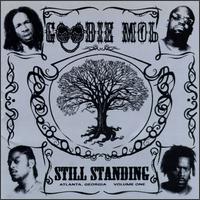The 13th installment of I Used to Love H.E.R., a series in which artists/bloggers/writers discuss their most essential or favorite hip-hop albums (read intro) comes from Jamie Radford, a Georgia-based hip-hop artist, lawyer, freelance writer and general Internet impresario. Jamie responded quickly and intelligently when I asked him to take part, and he schools us on the South.
Jamie Radford on MySpace | Jamie Radford’s blog | Jamie Radford at Last.fm
 Goodie Mob
Goodie Mob
Still Standing (LaFace, 1998)
“Still Standing” was one of those albums that hit me kind of late. It was something I bought early on in the history of my hip-hop fan-dom, probably because I found a used copy of it at Troy, Alabama’s only CD store, and I had heard “They Don’t Dance No Mo'” on Montgomery rap radio. And for a long time, it sat in its case, in my stack of neglected CD’s, until one day I randomly put it on, looking for some new sounds for my ears. I remember lying in my bed, half-asleep, just letting the music wash over me, when “Black Ice” starting floating through the air, and I was unexpectedly moved.
I say “unexpected,” because, at the time, South Alabama was being slammed with rap records out of New Orleans and Memphis: hard-hitting, instantly gratifying, glossy beats under drawled out hooks and shouts. For some reason, I had put Goodie Mob in the same mental compartment as these other Southern acts – like Atlanta’s version of Tru or Three-Six Mafia or something. I mean, they had “Mob,” in their name, and “They Don’t Dance No Mo'” usually followed “Make ‘Em Say Ungh” on the radio, so, why not?
But “Black Ice” was so smooth, and the raps were so … mentally stimulating. Listening to other Southern rappers, I had never been struck with the sense that rapping was a very difficult skill to acquire. But the opening verses were so complex, so quick, and what was this beat? This light organ floating in the background, these carefully placed kicks, this tick-tick that I sort of recognized. And then Gipp’s verse, then Big Boi’s, then.. holy shit.. Andre Benjamin’s. This was actually one of the first moments at which I really listened to either member of Outkast in this kind of light. This was probably the most skilled rapping I had ever heard.
When “They Don’t Dance” came on, I noticed elements I had never appreciated about this record. That little synth sound popping in the background, the depth of the verses. Then “Beautiful Skin!” Who was this strange-sounding rapper with this amazing verse about skillfully chatting up a dignified woman at a respectable singles joint? Was there other rap music out there like this? Needless to say, in the next weeks I got my hands on every Dungeon Family album available (Witchdoctor’s ” S.W.A.T. Healing Ritual, another favorite; Cool Breeze’s joint; all the Outkast albums available to date; the first Goodie Mob album). And for a while, these albums became permanent fixtures in my listening–I had been looking for a replacement for the Nirvana albums that had previously gotten me through each day, and I had found it. There was a darkness, a seriousness, an emotion in Goodie Mob that the other hip-hop I listened to hadn’t provided. It was a brand new kind of music.
The production on “Still Standing” is something that is still rare on hip-hop albums. The beats, like other Southern rap albums, are slow, with a prominent tick-tick double time represented in nearly every song. The vocal delivery has as much to do with inflection of the voice as with the content of the rhymes. But there’s also something unique about it. The samples are typically light and smooth (like the guitar part on “Beautiful Skin” or the brief piano and string hits on “Gutta Butta”), rather than the synth-blasts on No Limit or Cash Money records. The vocals have a heavy level of reverb, spreading the sound out throughout the beat, and smoothing out the overall mix.
And the lyricism is among the most complex recorded to date. Both Cee-Lo and Khujo’s raps take the form of fairly straightforward, interesting narratives, but both T-Mo and Gipp fill their verses with rhyme-heavy, drawled out word-pictures, packed with meaning and open to interpretation. Topping it all off are a couple of highly-memorable verses by Cee-Lo, most notably the tragic story of drug-dealing and prison at the end of “I Refuse Limitation” (which is also one of the most compelling hip-hop beats ever crafted), and the car-jacking tale in “Gutta Butta” (“I value both of our lives more than this here car!”).
“Still Standing,” along with the Fugee’s “The Score” is the album that most contributed to my love of and respect for hip-hop. And its still the album against which I sound-check all my own music: trying my best, usually in vain, to match the balance of bassy lows and stimulating highs, the level of reverb on the vocals, the gain on the snare. And now that I’ve moved to Atlanta, the album has acquired more meaning, as I pass by the name-checked streets and landmarks, and begin to better appreciate the city that inspired this music. I will forever remain in awe at the skill and attention to quality that went into this album, and can only hope that, in my own music, I maintain the integrity that Goodie Mob did in crafting “Still Standing.”
Goodie Mob | Black Ice

that is so crazy, i was just listening to goodie mob earlier and it was the same cd, i clicked on your bull because it said goodie mob and i think that was a hot article.